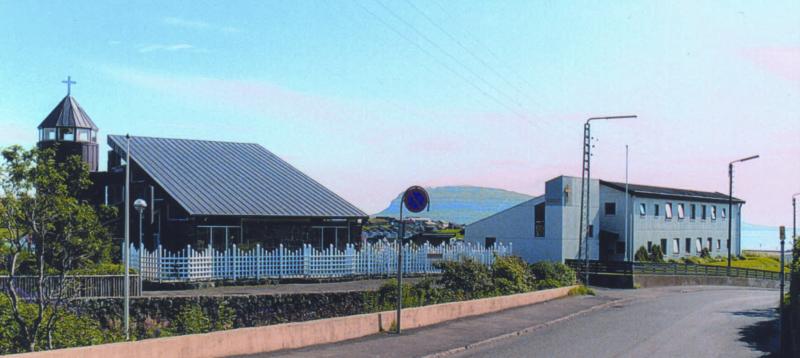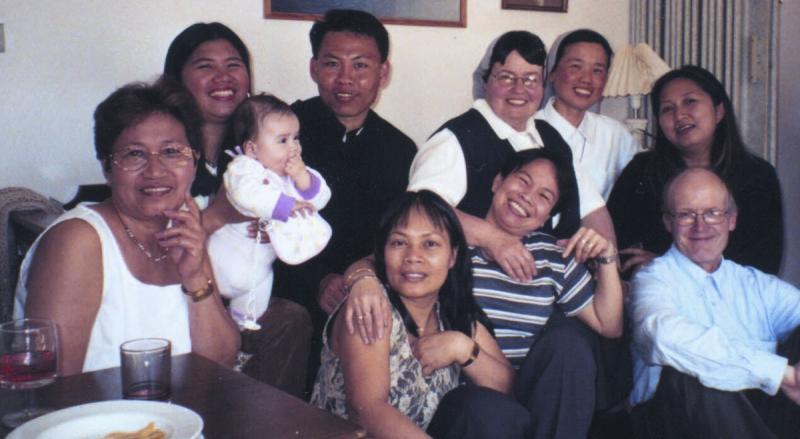Fiesta In The Faroes
by Father Seán Coyle
At 1am on Sunday, 30 July 2000, I was dancing with thousands of others in the streets of Tórshavn, the capital of the Faroe Islands. It was the culmination of the National Day, the feast of St Olav. We were doing the Faroese Circle Dance. This began with a singer leading a song that recounted the history of the people and seemed to have about 100 verses. Most knew the words. The circles of dancers formed all over the place until everyone was involved. It was quite impossible not to join in. The steps are very simple, two double steps left and one right. The dance to that first song lasted probably twenty minutes and was followed by another. No instruments are ever used.
‘Sheep Islands’
The Faroes consists of 18 islands, 16 of them inhabited, in the north Atlantic, between Iceland andNorway. The 45,000 people here, most of them members of the Lutheran State Church, enjoy some independence from Denmark since 1948. They have their own language and flag. Although Denmarkis a member of the European Union, the Faroes is not.
The name of the country, Føroyar in the Faroese language, means ‘sheep islands.’ Many families still come together late in the year when they slaughter a sheep to provide them with meat for the winter. They feast on what cannot be preserved.
Like a Philippine fiesta
One of the most striking things about the Faroes is the strong sense of community. This was very evident during the St Olav celebrations which began the afternoon before, just as Philippine fiestas do. There was a short parade in Tórshavn, where all the celebrations take place, ending at the parliament building, a traditional Faroese one with a grass roof. There was a brief speech or two and then all sang the National Anthem.
People then went down to the harbor to see the boat-races. There were races for men and for women, for crews of six, eight and ten. The teams came from different towns and villages. There was a fog over the harbor, something very common here, so you couldn’t see too clearly where the races began across the bay. But once the boats entered the harbor you got a good view. Many were listening to the commentary on the radio but didn’t seem to get too excited although they were clearly enjoying themselves. Many, young and old, were wearing traditional Faroese dress.
Faithful from all over
On the morning of the 29th at 11 the Lutheran bishop led a procession of the clergy and members of parliament to a nearby church for a service. In 2000, the millenium of Christianity in the country, clergy of other churches were invited for the first time. A married deacon represented the Catholic Church which has only about 80 members in the country, including about ten or twelve Filipinos. After the service the procession came back to the parliament building and there was a short choral concert that featured the premiere of a work by two young Faroese. This had won a competition for the Christian millenium.
Time to be merry
The town center was thronged most of the time and people bought food or entered contests at the many booths set up for the occasion, just as in the Philippines. I met one Filipina who had won a teddy bear. Many were walking around drinking alcohol. Alcoholism is a problem in the Faroes, as it is in all Nordic countries, but during the fiesta it doesn’t cause any real problems. I saw no rowdy behavior, though I heard that the police had locked up a few on the night of the vesperas to let them sober up. And I heard that they were called to one or two homes to deal with domestic disputes. But the fiesta ambience is one in which people can drink safely, even if many do so to excess.
Back (2nd, 3rd, 4th from left): Fr Quang (Vietnam), Sr Marisa FMM (Malta), Sr Florence FMM (Korea); front right: Deacon Christian Gabrielsen (Denmark) and Filipino parishioners in Klaksvik
Asian presence
As in the Philippines, many come home from overseas for the fiesta, Olavsvøka in Faroese. I met one woman home from Denmark with her adopted daughter, a Korean. There are quite a few here now in the Faroes who have been adopted from countries such as Korea and Colombia. What is very nice to see is someone in Faroese traditional dress and speaking Faroese who is clearly Asian by origin. One Catholic Faroese-Indian couple, Johann and Sharon, adopted a little Indian boy, Peter, in 1999. He was very proud to come to Mass in his Faroese costume.
Friends meet who haven’t met since the previous year and people in Tórshavn have plenty of food for visitors. The only Filipino family in the town had invited all the Filipinos in the islands and myself to drop by in the evening.
Language revival
Traditional songs, particularly those sung during the Circle Dance, saved the Faroese language. Some of them are very long and go back to the days of the original Viking settlers more than 1,000 years ago. It was only in 1938 that the Faroese language was given legal recognition by Denmark. Before that children were not allowed to speak it in school and Lutheran pastors were not allowed to preach in the language. Now it is used at every level and for every activity. Everyone learns Danish at school but you rarely hear it spoken. Most younger people can speak English quite well but never use it to impress anyone. Foreign TV programs on the local station, which broadcasts only in the evening, have Faroese subtitles. The country’s newspapers are in Faroese as are all the radio programs.
There was plenty of singing on the night of the fiesta. At 11 the Salvation Army led a service near the parliamentary building in which many joined in the hymns. This was in one sense a warm-up for the traditional community singing at midnight for which the town center was thronged with people of all ages. Some of the songs were old, some new, some serious, some humorous. At least two had imported melodies -- one used the tune of ‘When It’s Springtime in the Rockies.’ All were in Faroese and there were no soloists. This was a traditional community affair.
As one people
I found something very deep in all of this, beneath all the good humor. The Faroese people were celebrating themselves, their history, their ancestors, their language, their culture and, at least to some degree, their Christian faith. They had to struggle in the past to retain their language and culture. They have managed to strengthen their identity in a world that is in some ways becoming more and more culturally the same. The Faroes may be the only Western country without the McDonalds arch.
The at-homeness with themselves of the Faroese people is as refreshing as the extraordinarily pure air in these beautiful islands.


